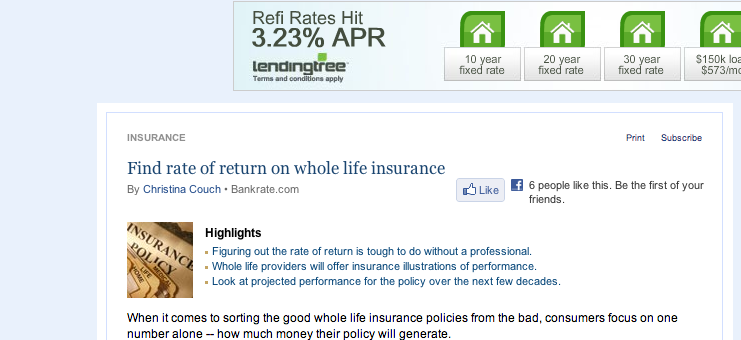Find the Rate of Return on Your Whole Life Insurance
Published August 4, 2011 on Bankrate.com
When it comes to sorting the good whole life insurance policies from the bad, consumers focus on one number alone — how much money their policy will generate.
To project how much money your policy will yield 10, 20 or even 30 years from now, insurance companies calculate the policy’s expected yearly growth. Better known as the “internal rate of return,” your IRR will dramatically change the longer you own the policy and will be a crucial factor for deciding whether it’s smarter to hold on to your policy or shop around for a new one.
Unfortunately, figuring out how much money your whole life policy is yielding now and what it will yield in the future is far more difficult than simply reading your policy’s fine print. Here are some tips for determining how much cash your cash value policy is really providing.
Don’t do it alone
Figuring out the rate of return on your whole life policy is almost impossible for consumers to do without help from the pros, says Tony Steuer, a life insurance analyst in Alameda, Calif., and author of “Questions and Answers on Life Insurance.”
“There are tons of moving parts to a lot of life insurance contracts … (and) insurance companies usually don’t disclose certain information to their customers, like if they’ve had a change in mortality rates,” he says.
Steuer adds that the method for calculating the rate of return on whole life insurance policies varies from company to company. While all companies factor in certain variables including how long you’ve owned the policy, dividends (if applicable) and mortality charges, how much each factor counts for varies significantly between insurance providers and policies.
Approach projections with caution
While whole life providers frequently won’t disclose how your rate of return is calculated, they will offer illustrations of how your policy is projected to perform in the future. All illustrations should include information on the costs of the policy, how much you’ve paid, your current death benefit and the cash surrender value you would get for canceling the policy today. It should also include future predictions on how your policy should perform five, 10 and 20 years down the road. The bad news is that insurance illustrations are lengthy, frequently riddled with tough-to-understand industry jargon and could include predictions so outrageously optimistic, there’s no way your policy will actually reach them.
“(Insurance illustrations) include a guaranteed column,” says Kelly O’Connor, managing agent with Mountain Financial, LLC, a wealth management group in Greenwood Village, Colo. This explains what the policy is guaranteed to look like over a certain time frame. “(Consumers) can trust that guaranteed piece of the illustration.”
In certain whole life contracts, O’Connor says that consumers can get an idea of how close other projections are by examining the company’s dividend payout history.
“All mutual insurance companies publish their dividend history, so if you look back and see that they’ve never been under 5.5 or 5.25 (percent dividends) for the last 100 years, there’s a pretty good chance that that will continue,” he says.
Look ahead
Cash value life insurance policies are designed to be long-term investments, not short-term ways to make a quick buck, says Glenn Daily, a Certified Financial Planner and fee-only insurance consultant based in New York City. To understand the rate of return for your policy, check out how the policy is projected to perform over the next few decades.
If you’re thinking of buying a new policy, “You need to see the average annual and year-by-year rate of return for at least the first 20 years,” says Daily. Those who already own policies should focus on the average annual and year-by-year rates of return for the next five to 10 years. By examining how their whole life policy is performing on a yearly basis, consumers get a firm idea of what kind of performance they can expect in the near future.
Consumers should know that the year-by-year rate of return will substantially differ from the rate of return generated over several years, says James H. Hunt, a life insurance actuary for the Consumer Federation of America and former insurance commissioner of Vermont.
“It may take as long as 10 years for the average annual rate of return on a cash value life insurance policy to turn positive, mainly due to heavy first year commissions and related sales expenses,” he says.
When comparing policies or deciding if it’s worthwhile to stick with the one you have, Hunt recommends hiring a third-party insurance analyst to evaluate whether a whole life policy makes sense in the long haul.
“It’s impossible to know what you’re getting into without hiring an expert,” he says.
—Christina Couch






